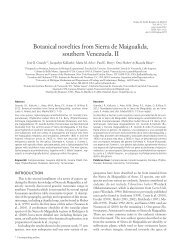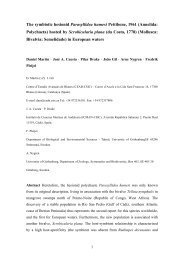PhD Thesis MJProl .pdf - digital-csic Digital CSIC - Consejo Superior ...
PhD Thesis MJProl .pdf - digital-csic Digital CSIC - Consejo Superior ...
PhD Thesis MJProl .pdf - digital-csic Digital CSIC - Consejo Superior ...
Create successful ePaper yourself
Turn your PDF publications into a flip-book with our unique Google optimized e-Paper software.
New strategies for the control of bacterial infections in marine fish larval rearing 3<br />
1. INTRODUCTION<br />
New strategies for the control of bacterial infections in<br />
marine fish larval rearing<br />
One of the limiting steps of marine fish aquaculture expansion is the supply of<br />
juvenile fish. Intensive fish larvae production is highly susceptible to the proliferation of<br />
bacteria, which may cause poor growth or mass mortality of the larvae. In most cases,<br />
mortality cannot be attributed to a specific pathogen, but to the proliferation of<br />
opportunistic bacteria (Olafsen, 1993, 2001). The rearing environment, with high larvae<br />
densities and high load of organic matter (from faeces, dead larvae debris or from live<br />
feed) is highly susceptible for bacterial growth. The control of bacteria in rearing<br />
systems and live feed production is a determinant factor for survival of fish larvae<br />
(Dhert et al., 2001; Planas and Cunha, 1999; Skjermo and Vadstein, 1999) and the<br />
increment in the survival of larvae treated with antibiotics supports this fact (Gatesoupe,<br />
1982, 1989; Pérez-Benavente and Gatesoupe, 1988).<br />
In aquatic environment, the use of antibiotics induces the development of<br />
resistances, which can be transferred to other bacteria, including pathogenic strains to<br />
fish or even humans (Cabello, 2006). Therefore, the use of antibiotics should be kept to<br />
a minimum. Vaccination of juveniles has drastically reduced the use of<br />
chemotherapeutics in aquaculture, increasing the survival of farmed fish. However, fish<br />
larvae have an undeveloped immune system, relying on maternal antibodies and non<br />
specific immune response (Vadstein, 1997), which prevents the use of vaccination.<br />
Usual approaches to control bacterial growth in intensive rearing of marine fish<br />
larvae are based on preventive hygienic measures, leading to the development of a clean<br />
environment, by seawater treatment processes (e.g. filtration, UV-irradiation,<br />
ozonization, disinfectants). Disinfection of fish eggs (Salvesen and Vadstein, 1995) and<br />
measures for control of bacterial microbiota in live feed such as, disinfection of rotifer<br />
eggs for the production of axenic cultures (Dhert et al., 2001; Douillet, 1998), treatment<br />
with hydrogen peroxide (Giménez et al., 2006) or ultraviolet radiation for partial<br />
decontamination (Munro et al., 1993, 1999) have been proposed but would be difficult<br />
to implement at industrial scale. Complete elimination of bacteria from the organisms<br />
and culture system is not possible, while disinfection implies in most cases the loss of a

















